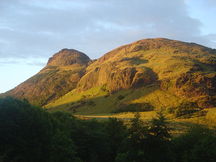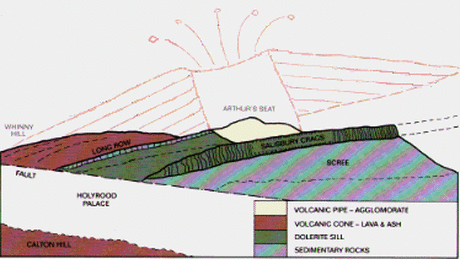|
For those of you who have ever been to Edinburgh and seen Arthurs Seat or even hiked up it, you will know that, once at the summit, it is one of the most awe-inspiring views of a city and can be quite windy! It is situated within Holyrood Park, which can be found very easily by walking to the end of the Royal Mile. And yes, it is the remains of an ancient volcano!  From wikipedia, Arthurs Seat on the left. The age of Arthurs seat is thought to be around 350 million years and as a consequence of its age has seen many glaciations which have scraped and eroded to leave the formation which is currently seen today. The summit of Arthurs seat is what remains of the volcanic conduit, whilst the long outline (photo at bottom) seen from the bottom of the royal mile is what remains of an ancient exposed basaltic sill. To the east of Arthurs seat is what remains of the volcanic cone which has been created from the outpourings of lava and ash from eruptions of the volcano. The volcanism in this region is the result of attempted rifting and the attempted seperation of rocks. From my understanding, and I am sure someone can tell me if I am wrong, the extension of the crust allows magma from depth to migrate up caused by a lowering of the melting point due to a decrease of pressure. For further information on Arthurs Seat and the geology of Edinburgh I highly recommend this site - the Geography Department of the University of Edinburgh. I will be uploading a panorama taken from the summit of Arthurs Seat soon, and will be posting tomorrow on the rock which the famous Edinburgh Castle sits upon. |
Archives
July 2023
|



 RSS Feed
RSS Feed